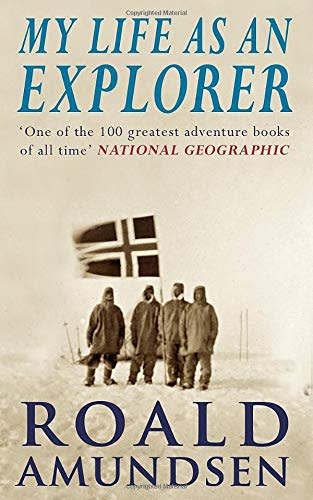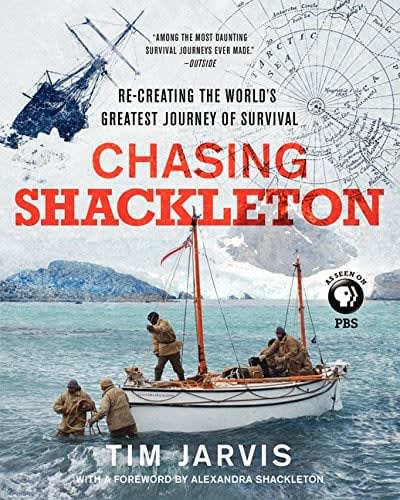I’ve been immersed lately in books about polar explorers. Perhaps it’s more accurate to say I’ve become obsessed with figuring out what compelled these adventurous souls to push their boundaries to explore beyond the polar horizons.
The titles that have especially intrigued me so far include My Life as an Explorer, by Roald Amundsen, which was first published in 1927, and Alfred Lansing’s gripping Endurance: Shackleton’s Incredible Voyage, published in 1959.


And, because I’m an impatient reader, I’m simultaneously tackling two books about modern-day explorers. One is Alone in Antarctica: The First Women to Ski Solo Across the Southern Ice, by Felicity Aston, who, in 2012, became the first person to ski solo across the Antarctic land mass. The other is Chasing Shackleton: Re-creating the World’s Greatest Journey of Survival, by Australian environmental scientist, author and explorer Tim Jarvis. It’s a detailed account of his 2013 re-enactment of Sir Ernest Shackleton’s legendary 1916 Antarctic journey from Elephant Island to South Georgia—in a replica of the 23-foot, open-wood boat James Caird. (Jarvis is one of the special guests on the upcoming voyage, Celebrating Shackleton: Journey from Antarctica to South Georgia. For anyone else who is curious to hear why someone would tackle this arduous 800-mile (1,300-kilometre) challenge accompanied only a small team decked out in early 1900s gear and no 21st-century navigation technology—this trip is for you.
And, of course, thanks to Google, I’ve been able to pour over snippets of diaries of polar explorers that were scribbled by light of candle in the cold depths of Antarctic nights more than 100 years ago.

Sir Ernest Shackleton (second from left) inspired generations of polar explorers who continued his legacy of Antarctic exploration.
We go beyond in the polar regions today by emulating the spirit of early polar explorers
What’s become increasingly evident as I absorb these books and biographical accounts is that each polar explorer—throughout history—has benefitted from the cumulative efforts, experiences, learnings and achievements of every polar hero who’s gone before.
The way I see it, Captain James Cook and his crew, who were the first to cross the Antarctic Circle in the 1770s, helped lay the groundwork for subsequent explorers like Captain James Weddell, who, in 1822, sailed to 74˚15’S and found the Weddell Ice Sheet and Sea. And Weddell’s discovery no doubt helped to inspire—and perhaps instruct—explorer James Clark Ross, who, in 1841, passed through what is now known as the Ross Sea and discovered Ross Island.
When Robert Falcon Scott arrived on the polar scene in the early 1900s, he had a wealth of information and previous polar discoveries to guide him when he led two expeditions to the Antarctic: the Discovery Expedition of 1901-1904 and the ill-fated Terra Nova Expedition of 1910-1913.
And so it went. The Shackletons, the Amundsens, even modern-day explorers like Ranulph Feinnes and Mike Stroud who, in 1992, became the first people to cross Antarctica unsupported—all of them were able to achieve great things thanks to previous polar achievements.
Building upon our own polar expertise decade after decade
That’s very much the trajectory of Quark Expeditions has followed. Generations of these early polar explorers have inspired our own expedition team as early as 1991. It was through the inspiration of these iconic names in polar history—and their knowledge—that enabled us to take the first consumer travelers to the North Pole. That legacy of learning has continued. The Quark Expeditions team today benefits from our first three decades of courageously exploring unknown destinations and pushing boundaries of polar adventure. Building on our own past successes has, in fact, culminated in our Antarctic 2021-22 season, which coincides with our 30th anniversary.

Quark Expeditions’ off-ship adventure options have evolved over the last three decades.
Expedition teams have built on the knowledge their predecessors .
Consider for a moment some of the highlights of our Antarctic 2021-22 season: two Total Solar Eclipse Voyages; a retracing of Shackleton’s Imperial Trans-Antarctic expedition of 1914–1917; the introduction of two twin-engine helicopters and 20 quick-launching Zodiacs; itineraries that include remote South Georgia, Patagonia, and the hard-to-reach Diego Ramirez and Cape Horn; and new adventure options such as heli-hiking and heli-landing.

Polar travelers today reap the benefits of generations of polar adventurers who pushed boundaries of exploration.

Quark Expeditions was the first company to offer hot-air ballooning in the Arctic. Such commitment to innovation spawned a robust portfolio of adventure options that are refined year after year.
The genesis of these incredible Antarctic offerings is rooted in every polar achievement, every innovation, of our first three decades.
We wouldn’t be who we are today had we not pushed boundaries of exploration since day one. Not only did we bring the first consumer travelers to the North Pole, we successfully led the first-ever passenger transit of the Northeast Passage (also in 1991), and the first-ever commercial passenger ship to circumnavigate Antarctica (in 1996). In 2004, Quark Expeditions became the first operator to confirm the Snow Hill emperor penguin colony. That enabled us in 2018 to take passengers through the ice-laden Weddell Sea to visit the penguin rookery at Snow Hill, making Quark Expeditions the operator with the most successful expeditions to this remote and difficult-to-reach destination.
In November 2003, we made history when we enabled 100 people, from 17 different nations, to witness a total solar eclipse from Antarctica—something no human had ever experienced. Everything our teams learned on that unforgettable voyage has enabled us to offer not one but two Total Solar Eclipse voyages this season—and with some of the same eclipse experts who joined us on that original 2003 voyage.

Quark Expeditions has acquired vast knowledge of polar vessels over three decades of exploring the Polar Regions. Pictured above: 30 Years of Victory, the iconic nuclear-powered ice-breaker..
About ten years ago, driven by our desire to innovate, we became the first tour operator to successfully offer passengers hot-air ballooning at the North Pole. Ever since then, season after season, we’ve experimented, invented and refined our off-ship activities for our guests. Today, Quark Expeditions has the largest portfolio of adventure options in the polar regions. With the introduction to our fleet of Ultramarine, with its two twin-engine helicopters, we now offer our guests helicopter-supported adventure options such as heli-hiking, heli-skiing and alpine kayaking. In fact, Ultramarine was conceived by the very people who’ve been leading polar expeditions for the last three decades.

The incredible experiences our guests enjoy today in the Antarctic are made possible
by the polar expertise accumulated over three decades.
Just as James Weddell learned from the earlier feats of James Cook, and similar to Robert Falcon Scott who benefited from the experiences of explorer James Clark Ross who journeyed before him, the present team at Quark Expeditions draws on the expertise of our first three decades of polar exploration. And no doubt the life-changing voyages and immersive polar experiences we create today—and constantly refine—will inspire our future expedition teams as they continue the journey of going beyond in the Polar Regions. That’s just as it should be.
Quark Expeditions’ status as the Leader of Polar Adventure is rooted in 30 years of expedition experience—in going beyond the familiar and predictable. I’m often reminded of the words of Sir Ernest Shackleton: “The world is a huge place. How will you know where you fit in unless you explore beyond your comfort zone?”










